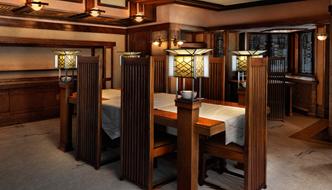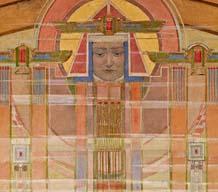Furniture and Decorative Arts
As Wright worked to define his vision for American architecture and design, the currents of Modernism coursed at home and abroad. Architects and designers in Europe, Great Britain and America integrated exterior and interior design principles to achieve a level of visual unity never seen before. From paintings and prints to light fixtures and furniture, the Modern style was pervasive, synthesizing every aspect of design as a Gesamtkunstwerk, a “total work of art.”
Wright’s ideology, like that of his international contemporaries, focused on the complete integration of the house ̶ site and structure, interior and exterior, furniture, ornament and architecture, every element of the design was connected. In the Wasmuth Portfolio (Berlin, 1910), Wright described his goal as such: "To thus make of a dwelling place a complete work of art… this is the modern American opportunity."
Bold, innovative, and architectural, the furnishings and decorative arts of Wright’s Chicago years were conceived as integral elements of his Prairie interiors, designed in harmony with each specific commission. Incorporating furniture, lighting, and decorative arts into the structure of his buildings enabled Wright to achieve a harmonious and unified interior.

Wright’s early oak furnishings, characterized by straight lines and rectilinear forms, are designed with the traditional Arts and Crafts preference for solidity and simplicity. In the early 1890s, as Wright worked to define his vision for a new American architecture, he began designing furniture for his own home in Oak Park. Built-in window seats and two sturdy oak armchairs, modeled on designs by English artist-designer William Morris, were executed for the living room between 1890-95. The dining table and eight high back chairs created for the 1895 dining room of the home were revolutionary for the time. Defined by an overriding verticality and simplicity, the suite of furniture marks a clear step toward a new aesthetic in Wright’s designs. The furniture forms an intimate secondary space in the room, the table shielded by the high backs of the dining chairs.
Wright’s interiors were further enriched by his innovative use of lighting. Wall sconces of leaded glass, oak, and bronze incorporated materials and motifs that echo those of the interiors of his buildings. Wright embraced the use of electricity early in his career, using incandescent lighting to complement natural light. In his own home, in place of a traditional chandelier hung above the dining table, Wright installed incandescent lighting recessed within the ceiling. Shielded behind rice paper and a decorative wood grille of stylized oak leaves and arabesques, the design was praised for its “great ingenuity” in the inaugural 1897 edition of The House Beautiful—"There is not a bulb in sight, but let into the ceiling and actually part of it, is a screen of intricate pattern, covered with thin paper. The light is turned on above and filters through much subdued.”

For the dining room of the Frederick C. Robie House in Chicago, Wright further integrated furniture and lighting. The table, modeled closely on the earlier design for Wright’s Oak Park home, features wood piers mounted with electrified fixtures of leaded glass. The fixtures of leaded glass contribute to the warm, intimate space created by the design of the furniture, while corresponding with the palette and form of the remarkable windows executed for the home.
Over the course of the 1890s, Wright also designed several decorative objects to be displayed in his buildings. Writing of these pieces in the Architectural Record of June 1900, Robert C. Spencer stated, “Among the decorative things in the Oak Park Studio are some very interesting vessels and flower-holders of sheet copper of Mr. Wright’s designs, always filled with masses of summer bloom or trophies of autumn fields and woods according to the season.”
Two of Wright’s most iconic decorative pieces include a bulbous copper urn and a slender attenuated vase, commonly referred to as a “weed-holder.” Designed in harmony with his interiors and furnishings, they complement the rectilinear geometry of Wright’s architecture. The designs were reproduced in a number of Wright’s building commissions during his Prairie years.

Further decorative embellishments—murals, sculptures, and leaded glass—were also integrated into the interior design scheme of the buildings. The draftsman Charles E. White noted of the playroom mural in Wright’s Oak Park home, “The decoration over Wright’s playroom mantel [shows] his idea of an architectural painting. The broad horizontal bands of decoration are architectural, and tie the painting to its surroundings.”
Writing of his aesthetic theories in the introduction to the Wasmuth Portfolio, Wright described his organic, unified interiors, declaring “They are all mere structural details in its character and completeness, heating apparatus, light fixtures, the very chairs, tables, cabinets and musical instruments, where practicable, are of the building itself. Nothing of appliances or fixtures is admitted purely as such where circumstances permit the full development of the building scheme. Floor coverings and hangings are a part of the house as the plaster on the walls or the tiles on the roof.”
